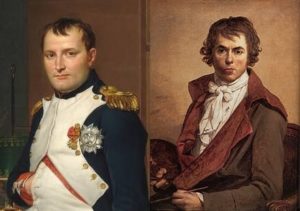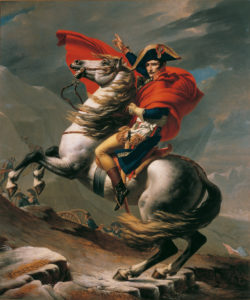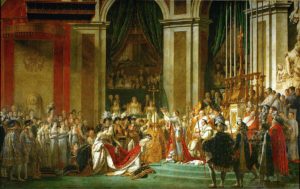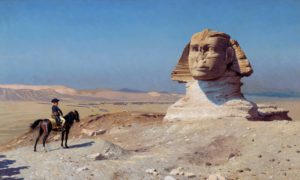
The Emperor Napoleon in His Study at the Tuileries by Jacques-Louis David (detail, left); Self-Portrait by Jacques-Louis David (right)
Ridley Scott’s latest historical epic film Napoleon, released in the US and UK on November 22nd, tries to tell the story of the Corsican-born French artillery general who ascended to rule most of Continental Europe for over a decade. Though Ridley Scott has drawn controversy with his comments on historical accuracy in filmmaking, the legendary British director did use several very well-known historical texts to craft some of the scenes for the film. We don’t often think of paintings as historical texts, but they very much are. And Jacques-Louis David’s depictions of Napoleon are very valuable documents indeed.
The relationship between Jacques-Louis David and Napoleon Bonaparte is an incredibly interesting one. Napoleon was already known for his military campaigns in Italy when he met the neoclassicist painter. Meanwhile, David’s reputation needed some rehabilitation at the time since, on top of being a well-known artist, he was a political revolutionary who served as a member of the Committee of General Security. This body, along with the Committee of Public Safety, were the two groups that organized and carried out the Reign of Terror, resulting in thousands of people being executed by the guillotine.
Napoleon understood that painters, particularly neoclassical artists like David, could be very useful. Napoleon sought to legitimize himself by crafting an image tying himself to old power structures, particularly the ethos and the imagery of the Roman Empire. To strengthen ties with France in 1801, King Charles IV of Spain commissioned David to commemorate Napoleon’s recent victory over the Austrians by creating a Roman-inspired equestrian portrait of him crossing the Alps at the St. Bernard Pass. Other artists like Paul Delaroche would later create more realistic depictions of the crossing, where Napoleon braved the high Alpine pass atop a mule led by a local peasant guide. However, David showed Bonaparte atop a stallion rearing up on its hind legs. Napoleon, resplendent in his military regalia, remains calm despite the gray storm clouds in the background and the wild look in his horse’s eye. Below the hoofs of his steed are names carved into the rock, documenting those great leaders who had made such journeys before, including Hannibal and Charlemagne. The name of Bonaparte is freshly carved right alongside them. While he did not commission the portrait, Napoleon understood the value of such an image. He ordered David to create several versions of the work, which would later hang at palaces in Paris, Madrid, and Milan to project Napoleon’s power. When Bonaparte became Emperor of the French in 1804, Jacques-Louis David became the official court painter.
In his official capacity as court painter, David created one of his most monumental works: The Coronation of Napoleon. The canvas is absolutely enormous, measuring just over 20 feet by 32 feet, making the figures almost life-size. It is currently one of the largest paintings on display at the Louvre in Paris. Ridley Scott made a concerted effort to recreate Napoleon’s coronation by drawing directly from David’s canvas. Despite the name, the painting does not actually show the moment of Napoleon‘s coronation. Rather, it shows another point in the ceremony when Napoleon crowned his wife Joséphine as his Empress. Over a hundred people populate the background, most of whose likenesses David made sure to recreate, including Napoleon’s siblings, members of his inner circle like Talleyrand and Murat, and Pope Pius VII, who extends his hand in benediction to bless the new emperor’s reign.
Despite the work’s accuracy in showing the many dignitaries in their robes and jewels, there are still features of the work that differ from the event’s reality. For instance, Joséphine is shown as far younger than she really was at the time. She was 41 years old, six years older than her husband. This has, in fact, been one of the major points of criticism directed at Scott’s film. While Vanessa Kirby is a phenomenal actress, casting Joséphine as a younger woman contradicts one of the defining aspects of Napoleon and Joséphine’s marriage. Given her age, Joséphine could not have any more children, leading to the couple’s later divorce. Furthermore, in the slightly elevated gallery in the painting’s background, Napoleon‘s mother, Maria Letizia, is placed in the direct center of the painting. However, Napoleon‘s mother was not in attendance. A rift had grown between her and her ambitious sons, leading to her missing the coronation. Similarly, Napoleon’s brother Joseph also refused to attend, yet he also appears in David’s painting. Of course, having a united family and a young wife ready to produce an heir were both images Napoleon sought to project through the coronation painting. This projection extends itself into Scott’s film, which seems to have remained more faithful to David’s work than the historical record. The film’s coronation scene is portrayed as depicted in the famous painting, with Napoleon’s mother and a much younger Joséphine to match. Even David himself briefly appears, sketching away at an easel to capture the moment.
Until Ridley Scott’s movie, for me, the defining depiction of Napoleon in film or television was in the 2002 miniseries Napoléon. The French actor Christian Clavier plays the emperor, while Joséphine is played by the great Italian actress Isabella Rossellini. Like Scott’s movie, the miniseries also tries to show Napoleon’s coronation, seemingly trying to recreate David’s work. However, while the 2023 movie leans into Jacques-Louis David’s propaganda to capture a sense of grandeur and majesty, the 2002 miniseries has an incredibly interesting moment after the coronation scene. Napoleon appears in David’s workshop, with The Coronation of Napoleon taking up the entire wall. Napoleon marvels at David’s accuracy in the likenesses of the individual figures present in the work. He notices that his mother is not depicted, prompting David to remind him that his mother refused to attend. The emperor points to the middle of the canvas and says, “Here. Paint her right here. Make her easy to see. Give her a beautiful dress and see that she looks radiant.” The 2023 film also had a moment in David’s studio after the coronation, but by that point, the characters’ minds were elsewhere.
While the Ridley Scott film certainly had the bigger budget to provide audiences with better effects, better costumes, better cinematography, and so on, it was a made-for-TV miniseries from over twenty years ago that captured the essence of Napoleon. Ridley Scott gives us the spectacle of Jacques-Louis David’s work but fails to show us how aware Napoleon was of his image and how egotistical he was. That is not to say that Ridley Scott’s Napoleon is humble. Lines like “I am not built like other men” and “My destiny is more powerful than my will” aren’t exactly uttered by people known for humility. But Joaquin Phoenix played the emperor as the great stoic man of history rather than the passionate, energetic man Napoleon was. In the 2002 miniseries, we see both the grandeur of the coronation and details of the behind-the-scenes work, showing an incredibly charismatic person ensuring that everything is exactly how he wants people to see it.
Of course, David was far from the only painter to produce propaganda on Napoleon’s behalf. Both François Gérard and Jean-Auguste-Dominique Ingres created portraits of Napoleon in his lavish coronation robes. The former shows him in a way similar to past European kings, while the latter shows him enthroned, like how Jupiter might be depicted. Antoine-Jean Gros, one of David’s students, created Bonaparte Visiting the Plague Victims of Jaffa in 1804, showing an episode from the Egyptian campaign five years earlier. Napoleon personally commissioned this work to counter rumors that he had ordered the execution of sick soldiers. Here, Gros shows the general reaching out to touch one of the plague victims, much to his terrified entourage’s chagrin. This painting was meant to show Napoleon as a compassionate figure, similar to the biblical story of Jesus healing the leper. Even decades after Napoleon’s death, great painters like Jean-Léon Gérôme were immortalizing the emperor in paintings like Bonaparte Before the Sphinx, which Scott also recreated in his film.
If there’s one lesson to be learned from Ridley Scott’s film, it’s that even before the age of mass media, powerful people cared very much about their image and took measures to enhance it. The big-budget biopic may certainly bring to life Napoleon’s larger-than-life personality and the scale of the events he facilitated for modern audiences. However, by only looking at the carefully crafted image he created for himself, we only have a partial portrait of one of the most influential people who has ever lived.



